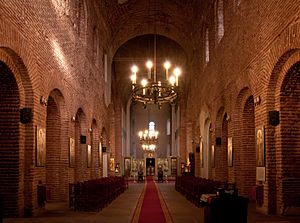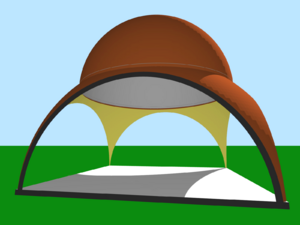Byzantine architecture facts for kids
Byzantine architecture is a special way of designing buildings. It was used in the Byzantine Empire. This empire was also known as the Eastern Roman Empire. Its main city was Constantinople (today's Istanbul). The Byzantine Empire lasted for over 1,000 years!
Its building style had a big impact. It influenced buildings in Europe and the Near East during the Middle Ages. It also inspired later styles like Renaissance architecture and Ottoman architecture.
Contents
What Makes Byzantine Buildings Special?
Early Byzantine buildings grew from Early Christian architecture. Those older buildings were often long halls called basilicas. They usually had flat wooden roofs. Big round domes were not used very often back then.
Byzantine architecture changed this. It often used large domes. These domes were a key part of the design. They also used half-domes, especially above a rounded space called an apse.
The Clever Pendentive
One very clever invention was the pendentive. This is a curved, triangle-shaped support. It helps place a round dome on top of a square room. Imagine four curved triangles. They sit on the corners of a square. Then, a round dome can sit perfectly on top of them.
This smart design became popular in the 6th century. It was during the time of Byzantine Emperor Justinian I. This is when Byzantine architecture truly became its own unique style.
Domes with Windows
Another special feature was domes with many windows. These windows were placed around the base of the dome. When light shone through, it made the dome look amazing. It was like a sparkling crown made of light.
How Byzantine Architecture Influenced Others
In Western Europe, new styles like Romanesque and Gothic architecture took over. But Byzantine architecture still had a big impact.
In Asia, it influenced early Islamic architecture. Later, the Ottoman architecture also took many ideas from the Byzantine style. You can see its influence in many famous buildings around the world.
Images for kids
-
Interior of the Basilica of San Vitale from Ravenna (Italy), decorated with elaborate and glamorous mosaics
-
Pammakaristos Church, also known as the Church of Theotokos Pammakaristos (Greek: Θεοτόκος ἡ Παμμακάριστος, "All-Blessed Mother of God"), is one of the most famous Greek Orthodox Byzantine churches in Istanbul
-
Hagia Irene is a Greek Eastern Orthodox Church located in the outer courtyard of Topkapı Palace in Istanbul. It is one of the few churches in Istanbul that has not been converted into a mosque
-
External view of the 11th-century monastery of Hosios Loukas in Greece. It is representative of the Byzantine art during the rule of the Macedonian dynasty (Macedonian art)
-
Interior of the Hagia Sophia under renovation, showing many features of the grandest Byzantine architecture.
-
Chora Church medieval Byzantine Greek Orthodox church preserved as the Chora Museum in the Edirnekapı neighborhood of Istanbul
-
The 9th century Throne Hall of Dongola in Sudan was heavily influenced by Byzantine architecture.
-
Byzantine Ionic column from National Museum of Medieval Art (Korçë, Albania)
-
Byzantine composite column from Basilica of Sant'Apollinare Nuovo (Ravenna, Italy)
-
Byzantine basket column from Hagia Sophia (Istanbul, Turkey)
-
One of the most famous of the surviving Byzantine mosaics of the Hagia Sophia in Istanbul, Turkey
-
Byzantine mosaics in St Mark's Basilica, Venice, Italy
-
Mosaic above the entrance portal of the Euphrasian Basilica in Poreč, Croatia (6th century)
See also
 In Spanish: Arquitectura bizantina para niños
In Spanish: Arquitectura bizantina para niños





























